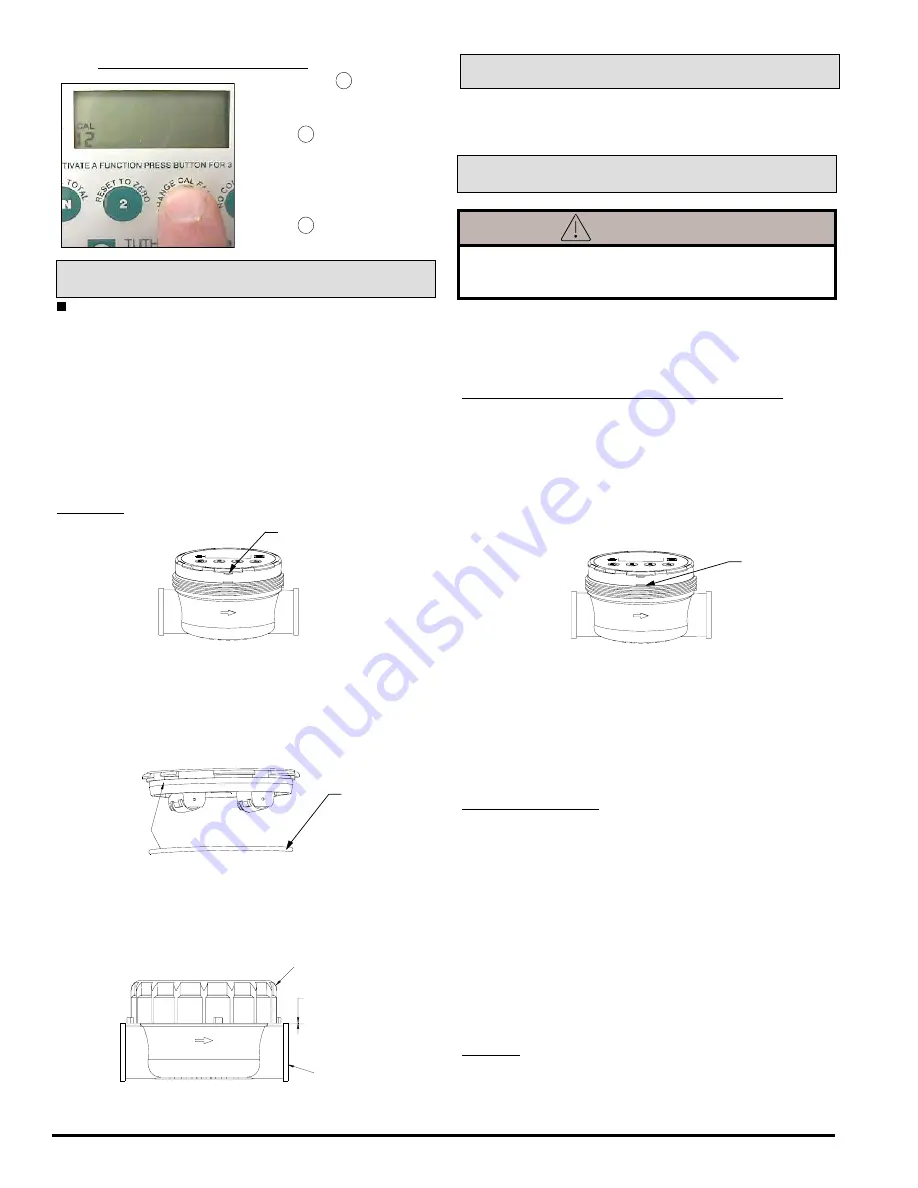
6
Thorough Cleaning (refer to exploded view)
Thorough Cleaning (refer to exploded view)
Thorough Cleaning (refer to exploded view)
Thorough Cleaning (refer to exploded view)
Thorough Cleaning (refer to exploded view)
If meter is plugged due to hardened chemical or debris, do
the following:
1. Drain all fluid from meter.
2. Unscrew meter cap (item 1). Use a strap type oil filter
wrench or large 5" jaw pipe wrench if necessary.
3. Insert a flat-head screwdriver in the lower slot (see Figure 7)
and turn to pry up meter cover (item 6).
3. Remove old batteries and insert new batteries, making sure
battery polarity is correct, or meter damage could occur.
4. As noted in Figure 5, reinstall o-ring on electronics module.
Align sensor receptacle in proper location. Press module
gently down into meter cover.
Figure 6
1/8" GAP
CAP
RIDGE ON
OUTLET PORT
5. Thread on meter cap until hand tight. To check tightness,
there should be 1/8" gap between cap and ridge on outlet
port. (See Figure 6).
O-Ring
Figure 5
REPAIR
If any meter components are damaged, they should be re-
placed. See meter drawing and parts list for correct replace-
ment part number before ordering.
Meter should be flushed between uses with water to prevent
chemicals from drying and plugging meter.
MAINTENANCE
Follow fluid manufacturer's recommended procedures
for handling and disposing of metered fluids.
CAUTION
Figure 7
Lower Pry Slot
4. The meter chamber (item 8) can now be removed.
5. Rinse all meter components with flushing fluid. Do NOT
submerge display assembly. Be careful not to get any fluid
or dirt in the electronics module.
6. Reassemble meter.
CALIBRATION NOTE: Over time, the chamber inside the 825
meter will wear, requiring the meter to be recalibrated with
water. When this should be done depends on the
amount and type of fluid dispensed. In most crop protection
fluid uses (less than 1000 gallons of a clean fluid per year), the
825 meter will remain accurate for many years without
recalibration. On the other hand, dispensing an abrasive
fluid may require more frequent recalibration.
The 825 meter is designed to be calibrated with clean water
for safe handling. See "Water Calibration" section in Appen-
dix-B.
NOTE
: Low battery icon will flash when batteries begin to
lose power. Meter still functions properly for several days after
the icon begins to flash. Neither calibration, current total or
totalizer quantities will be lost when replacing batteries.
To Replace Batteries
To Replace Batteries
To Replace Batteries
To Replace Batteries
To Replace Batteries (refer to exploded view)
1. Unscrew meter cap (item 1). Use a strap type oil filter wrench
or large 5" jaw pipe wrench if needed.
2. Insert a flat-head screw driver into the top slot (see Figure
4) and gently pry up electronics module.
CAUTION: Be careful not to get fluid or dirt in electronics area.
Figure 4
Upper Pry Slot
CHANGING THE CAL FACTOR
CHANGING THE CAL FACTOR
CHANGING THE CAL FACTOR
CHANGING THE CAL FACTOR
CHANGING THE CAL FACTOR
• Hold button 3 until the
display only shows CAL and
number.
• Press 3 repeatedly until
you reach the desired
number. Note – number will
increment up to 19, then
back to zero.
• Press 2 to return to
normal operating mode.
Storage
Storage
Storage
Storage
Storage
Store in a cool, dry place. Drain out all fluid that could freeze
in the meter.
BATTERIES






























